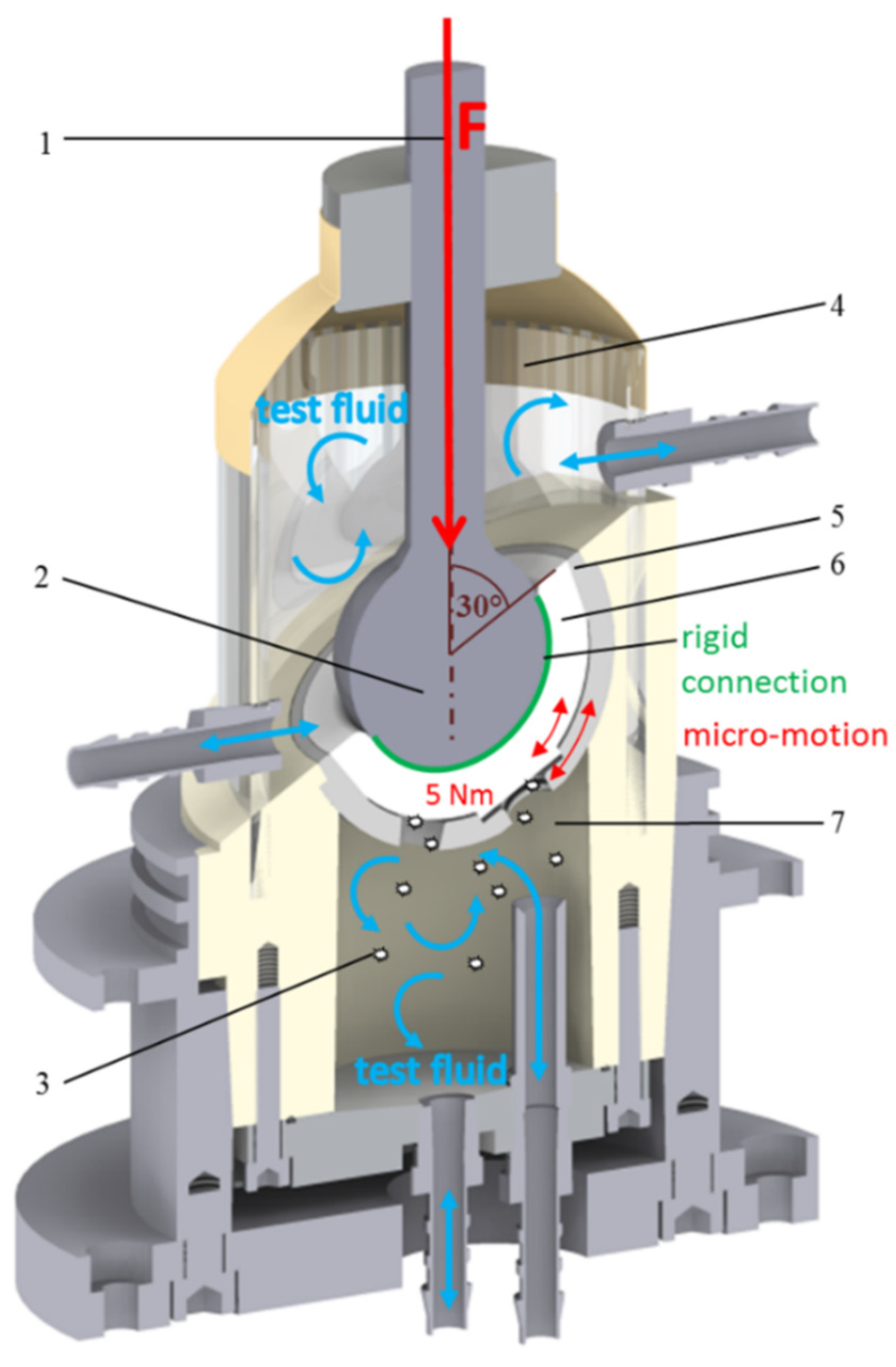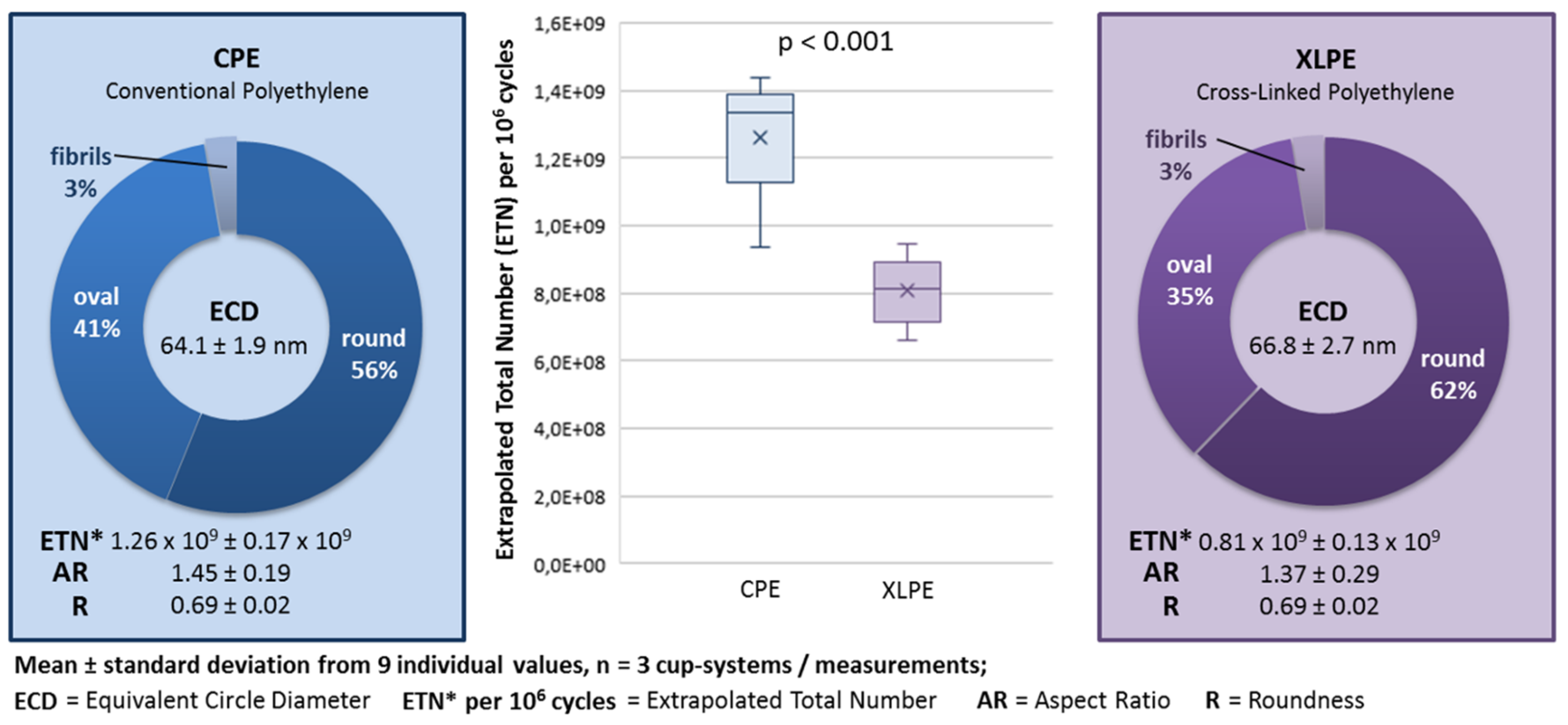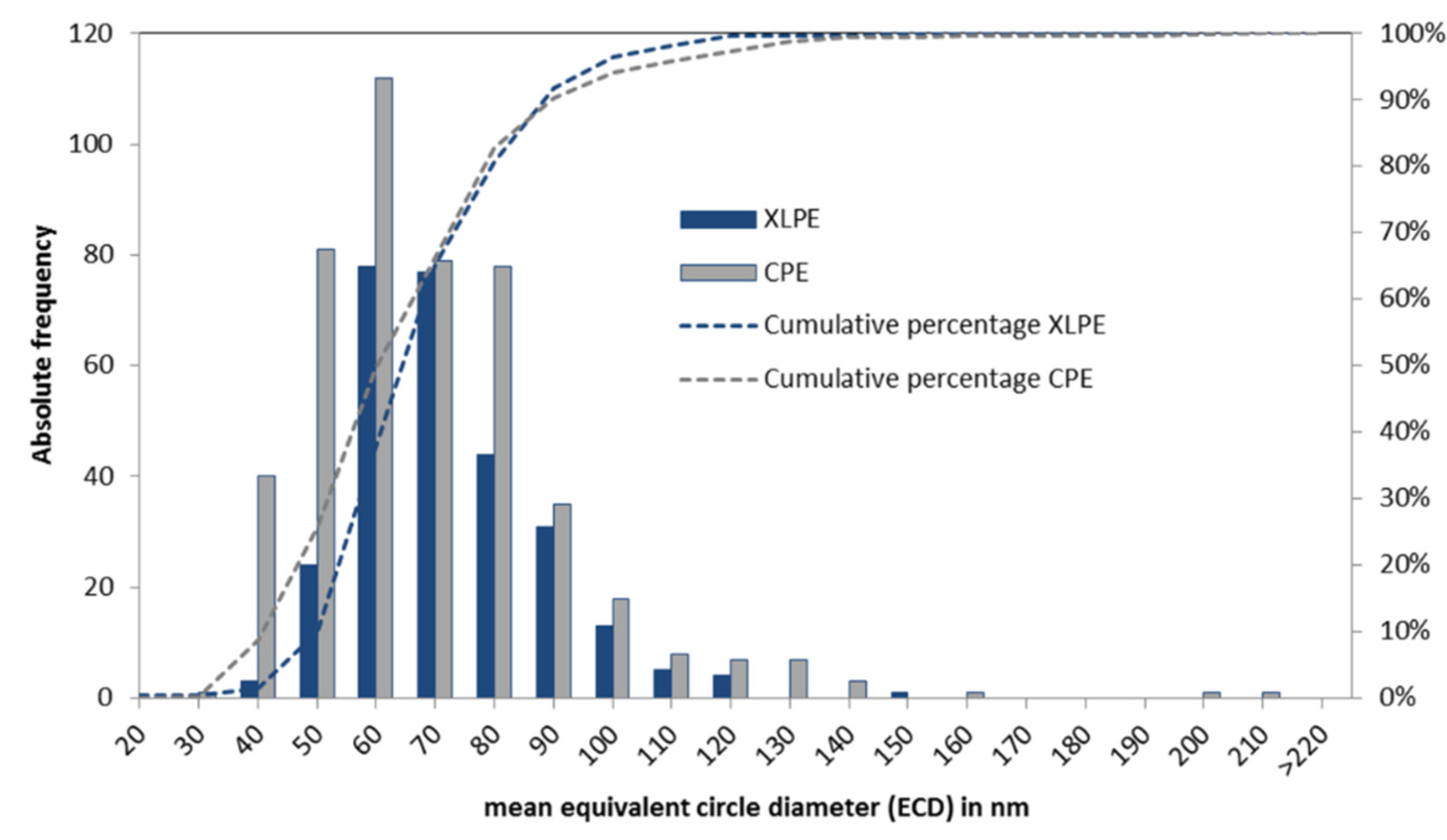Quantitative Measurements of Backside Wear in Acetabular Hip Joint Replacement: Conventional Polyethylene Versus Cross-Linked Polyethylene
Abstract
1. Introduction
2. Materials and Methods
2.1. Experimental Groups
2.2. Analyzed Components
2.3. Test Setup
2.4. Wear Analysis
2.5. Statistics
3. Results
4. Discussion
5. Limitations
6. Conclusions
Author Contributions
Funding
Acknowledgments
Conflicts of Interest
References
- Affatato, S.; De Mattia, J.S.; Bracco, P.; Pavoni, E.; Taddei, P. Wear performance of neat and vitamin E blended highly cross-linked PE under severe conditions: The combined effect of accelerated ageing and third body particles during wear test. J. Mech. Behav. Biomed. Mater. 2016, 64, 240–252. [Google Scholar] [CrossRef]
- Garvin, K.L.; White, T.C.; Dusad, A.; Hartman, C.W.; Martell, J. Low Wear Rates Seen in THAs With Highly Crosslinked Polyethylene at 9 to 14 Years in Patients Younger Than Age 50 Years. Clin. Orthop. Relat. Res. 2015, 473, 3829–3835. [Google Scholar] [CrossRef] [PubMed]
- Fukui, K.; Kaneuji, A.; Sugimori, T.; Ichiseki, T.; Matsumoto, T. Wear Comparison between Conventional and Highly Cross-Linked Polyethylene Against a Zirconia Head. J. Arthroplast. 2013, 28, 1654–1658. [Google Scholar] [CrossRef] [PubMed]
- Deutschland, E. Jahresbericht 2017—Mit Sicherheit mehr Qualität; EPRD Deutsches Endoprothesenregister gGmbH: Berlin, Germany, 2017. [Google Scholar]
- Graves, S.; Davidson, D.; Ingerson, L.; Ryan, P.; Griffith, E.C.; McDermott, B.F.J.; McElroy, H.J.; Pratt, N. The Australian Orthopaedic Association National Joint Replacement Registry. Med. J. Aust. 2004, 180, S31–S34. [Google Scholar] [CrossRef] [PubMed]
- Bistolfi, A.; Bellare, A. The relative effects of radiation crosslinking and type of counterface on the wear resistance of ultrahigh-molecular-weight polyethylene. Acta Biomater. 2011, 7, 3398–3403. [Google Scholar] [CrossRef]
- Oral, E.; Muratoglu, O.K. Vitamin E diffused, highly crosslinked UHMWPE: A review. Int. Orthop. 2010, 35, 215–223. [Google Scholar] [CrossRef]
- Grupp, T.M.; Holderied, M.; Mulliez, M.A.; Streller, R.; Jäger, M.; Blömer, W.; Utzschneider, S. Biotribology of a vitamin E-stabilized polyethylene for hip arthroplasty—Influence of artificial ageing and third-body particles on wear. Acta Biomater. 2014, 10, 3068–3078. [Google Scholar] [CrossRef]
- Braun, S.; Sonntag, R.; Schroeder, S.; Mueller, U.; Jäger, S.; Gotterbarm, T.; Kretzer, J.P. Backside wear in acetabular hip joint replacement. Acta Biomater. 2019, 83, 467–476. [Google Scholar] [CrossRef]
- Illgen, R.L.; Forsythe, T.M.; Pike, J.W.; Laurent, M.P.; Blanchard, C.R. Highly Crosslinked vs Conventional Polyethylene Particles—An In Vitro Comparison of Biologic Activities. J. Arthroplast. 2008, 23, 721–731. [Google Scholar] [CrossRef]
- Oral, E.; Christensen, S.D.; Malhi, A.S.; Wannomae, K.K.; Muratoglu, O.K. Wear Resistance and Mechanical Properties of Highly Cross-linked, Ultrahigh–Molecular Weight Polyethylene Doped With Vitamin E. J. Arthroplast. 2006, 21, 580–591. [Google Scholar] [CrossRef]
- Affatato, S.; Bersaglia, G.; Rocchi, M.; Taddei, P.; Fagnano, C.; Toni, A. Wear behaviour of cross-linked polyethylene assessed in vitro under severe conditions. Biomaterials 2005, 26, 3259–3267. [Google Scholar] [CrossRef] [PubMed]
- Ingram, J.H.; Stone, M.; Fisher, J.; Ingham, E. The influence of molecular weight, crosslinking and counterface roughness on TNF-alpha production by macrophages in response to ultra high molecular weight polyethylene particles. Biomaterials 2004, 25, 3511–3522. [Google Scholar] [CrossRef] [PubMed]
- Scemama, C.; Babinet, A.; Dumaine, V.; Courpied, J.P.; Hamadouche, M.; Anract, P. Does vitamin E-blended polyethylene reduce wear in primary total hip arthroplasty: A blinded randomised clinical trial. Int. Orthop. 2016, 41, 1113–1118. [Google Scholar] [CrossRef] [PubMed]
- Hanna, S.; Somerville, L.; McCalden, R.W.; Naudie, D.D.; Macdonald, S.J. Highly cross-linked polyethylene decreases the rate of revision of total hip arthroplasty compared with conventional polyethylene at 13 years’ follow-up. Bone Jt. J. 2016, 98, 28–32. [Google Scholar] [CrossRef]
- Standard Practice for Characterization of Particles; ASTM F1877-16; American Society for Testing and Materials: West Conshohocken, PA, USA, 2010.
- Catelas, I.; Bobyn, J.D.; Medley, J.B.; Krygier, J.J.; Zukor, D.J.; Huk, O.L. Size, shape, and composition of wear particles from metal-metal hip simulator testing: Effects of alloy and number of loading cycles. J. Biomed. Mater. Res. 2003, 67, 312–327. [Google Scholar] [CrossRef]
- Oral, E.; Wannomae, K.K.; Bichara, D.A.; Micheli, B.; Doshi, B.N.; O’Brien, C.; Nielsen, G.P.; Muratoglu, O.K. An antioxidant stabilized, chemically cross-linked UHMWPE with superior toughness. J. Biomed. Mater. Res. Part B Appl. Biomater. 2018, 107, 1945–1952. [Google Scholar] [CrossRef] [PubMed]
- Nakashima, Y.; Sato, T.; Yamamoto, T.; Motomura, G.; Ohishi, M.; Hamai, S.; Akiyama, M.; Hirata, M.; Hara, D.; Iwamoto, Y. Results at a minimum of 10years of follow-up for AMS and PerFix HA-coated cementless total hip arthroplasty: Impact of cross-linked polyethylene on implant longevity. J. Orthop. Sci. 2013, 18, 962–968. [Google Scholar] [CrossRef]
- Beksaç, B.; Salas, A.; Della Valle, A.G.; Salvati, E.A. Wear is Reduced in THA Performed with Highly Cross-linked Polyethylene. Clin. Orthop. Relat. Res. 2008, 467, 1765–1772. [Google Scholar] [CrossRef]
- Mall, N.A.; Nunley, R.M.; Zhu, J.J.; Maloney, W.J.; Barrack, R.L.; Clohisy, J.C. The Incidence of Acetabular Osteolysis in Young Patients with Conventional versus Highly Crosslinked Polyethylene. Clin. Orthop. Relat. Res. 2010, 469, 372–381. [Google Scholar] [CrossRef]
- Sethi, R. Macrophage response to cross-linked and conventional UHMWPE. Biomaterials 2003, 24, 2561–2573. [Google Scholar] [CrossRef]
- Baxter, R.M.; Macdonald, D.W.; Kurtz, S.M.; Steinbeck, M.J. Characteristics of highly cross-linked polyethylene wear debris in vivo. J. Biomed. Mater. Res. Part B Appl. Biomater. 2013, 101, 467–475. [Google Scholar] [PubMed]
- Ormsby, R.T.; Solomon, L.B.; Yang, D.; Crotti, T.N.; Haynes, D.R.; Findlay, D.M.; Atkins, G.J. Osteocytes respond to particles of clinically-relevant conventional and cross-linked polyethylene and metal alloys by up-regulation of resorptive and inflammatory pathways. Acta Biomater. 2019, 87, 296–306. [Google Scholar] [CrossRef] [PubMed]
- Fisher, J.; McEwen, H.M.J.; Tipper, J.L.; Galvin, A.; Ingram, J.; Kamali, A.; Stone, M.H.; Ingham, E. Wear, debris, and biologic activity of cross-linked polyethylene in the knee: Benefits and potential concerns. Clin. Orthop. Relat. Res. 2004, 114–119. [Google Scholar] [CrossRef] [PubMed]
- Braun, S.; Vardag, S.; Mueller, U.; Schroeder, S.; Sonntag, R.; Bormann, T.; Gotterbarm, T.; Kretzer, J.; Gotterabarm, T. Backside wear, particle migration and effectiveness of screw hole plugs in acetabular hip joint replacement with cross-linked polyethylene. Acta Biomater. 2019, 97, 239–246. [Google Scholar] [CrossRef]
- Sonntag, R.; Braun, S.; Al-Salehi, L.; Reinders, J.; Mueller, U.; Kretzer, J.P. Three-dimensional friction measurement during hip simulation. PLoS ONE 2017, 12, e0184043. [Google Scholar] [CrossRef]





© 2020 by the authors. Licensee MDPI, Basel, Switzerland. This article is an open access article distributed under the terms and conditions of the Creative Commons Attribution (CC BY) license (http://creativecommons.org/licenses/by/4.0/).
Share and Cite
Braun, S.; Jaeger, S.; Sonntag, R.; Schroeder, S.; Kretzer, J.P. Quantitative Measurements of Backside Wear in Acetabular Hip Joint Replacement: Conventional Polyethylene Versus Cross-Linked Polyethylene. Materials 2020, 13, 1854. https://doi.org/10.3390/ma13081854
Braun S, Jaeger S, Sonntag R, Schroeder S, Kretzer JP. Quantitative Measurements of Backside Wear in Acetabular Hip Joint Replacement: Conventional Polyethylene Versus Cross-Linked Polyethylene. Materials. 2020; 13(8):1854. https://doi.org/10.3390/ma13081854
Chicago/Turabian StyleBraun, Steffen, Sebastian Jaeger, Robert Sonntag, Stefan Schroeder, and J. Philippe Kretzer. 2020. "Quantitative Measurements of Backside Wear in Acetabular Hip Joint Replacement: Conventional Polyethylene Versus Cross-Linked Polyethylene" Materials 13, no. 8: 1854. https://doi.org/10.3390/ma13081854
APA StyleBraun, S., Jaeger, S., Sonntag, R., Schroeder, S., & Kretzer, J. P. (2020). Quantitative Measurements of Backside Wear in Acetabular Hip Joint Replacement: Conventional Polyethylene Versus Cross-Linked Polyethylene. Materials, 13(8), 1854. https://doi.org/10.3390/ma13081854




